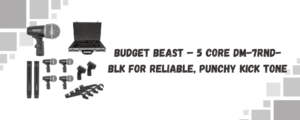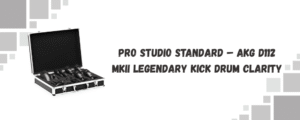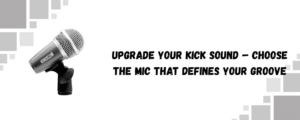Buying a kick drum mic shouldn’t be about guesswork. You’re not just looking for any mic that fits inside the drum shell. You want one that hits hard, translates the low-end without getting muddy, and doesn’t choke when the volume spikes live or in the studio.
Whether you’re building a full mic setup from scratch or just upgrading your current kick mic, this is where the tone starts. Let’s get right into it.
Why Your Kick Mic Matters More Than You Think
For most drummers, the kick drum is the heartbeat of their sound. It’s where punch, clarity, and power come together—and if your mic can’t translate that with accuracy, it throws off the whole mix. A cheap or poorly matched mic will either flatten the lows or overhype the click, giving you something lifeless or downright unusable.
That’s why investing in the right mic here is non-negotiable. And yes, it is possible to get pro-level results without dropping a fortune.
The All-Rounder Starter: 5 Core DM-7RND-BLK
The DM-7RND-BLK isn’t just a solid entry point—it’s a full 7-piece drum mic kit that’s surprisingly kick-focused for the price. The dedicated bass drum mic in this kit handles SPL like a champ and scoops just enough mids to carve space in your mix without killing tone. It’s pre-tuned with a round, tight bottom end and a touch of attack—ideal for live shows or rehearsal recordings.
Plus, the rest of the kit gives you flexibility. You can build around the kick and expand at your own pace.
For anyone looking to buy a kick drum mic without blowing their budget, this one offers legit value straight out of the gate.
The Pro Standard: AKG D112 MKII
If you’ve stepped into any commercial studio or venue, you’ve seen this mic. The AKG D112 MKII has earned its place as one of the best bass drum microphones on the market for a reason. It handles insane SPL, keeps the low-end clean, and gives you a natural punch that doesn’t need heavy EQ.
Where the D112 really shines is in clarity. Even with double-pedal blast beats or complex footwork, it doesn’t fold. And if you’re tracking in the studio, the built-in resonance chamber gives you a rounded thump that sits beautifully in a full mix.
It’s the kind of mic you buy once and keep forever—no need to upgrade.
Key Differences That Actually Matter
Both of these mics do their job well—but for different types of players.
- Budget and Versatility? Go for the 5 Core DM-7RND-BLK. You’re not just getting a capable kick mic—you’re getting a full kit that punches above its price.
- Professional Studio Use? The AKG D112 MKII is still the industry benchmark. If your sessions are high-stakes or you’re capturing every nuance, this is your mic.
And if you’re serious about building a professional kick sound, it’s not a bad idea to grab both. Use the 5 Core for rehearsals and road gigs. Keep the AKG in your studio rack. Each has its place.
What to Look For Before You Buy
If you’re actively shopping and comparing, here are a few quick checks before pulling the trigger:
- High SPL handling. Kick drums are brutal. If your mic clips under pressure, it’s a dealbreaker.
- Sculpted frequency response. Look for something that boosts the low end and gives you that 4–6 kHz attack range.
- Mounting flexibility. Does the mic come with a proper clip or mount? You don’t want to be rigging workarounds on stage.
- Build quality. All-metal body, road-ready housing, and decent isolation are musts for live use.
Final Word: One Mic, Huge Impact
It’s easy to get lost in tom mics, overheads, and exotic snare options—but when your kick drum lacks definition, the whole kit suffers. Your mix loses punch. Your groove loses power.
If you’re looking to buy a kick drum mic that delivers deep, powerful bass without compromise, start smart. Whether it’s the full-featured 5 Core DM-7RND-BLK or the legendary AKG D112 MKII, each of these options gives you serious tone that translates.
Your kick drum isn’t just background noise. Treat it like the main event.




